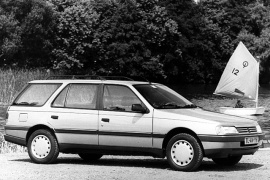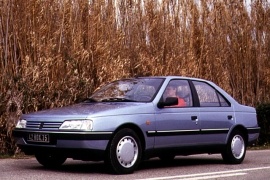PEUGEOT 405 Models/Series Timeline, Specifications & Photos
First production year: 1987
Engines: Gasoline, Diesel
The mid-size sedan Peugeot 405 was introduced in 1997 as a direct successor for both the smaller 305 and the bigger 505. The result was one of the most successful Peugeot sedans ever made.
With a sharp-looking and sporty style, the 405 sedan was an instant hit on the market and was the best-sold sedan in its class on several markets. One year later, in 1988, the station-wagon version was launched. It was another hit for Peugeot, who was one of the most appreciated French station-wagon producers.
Unlike some of the other Peugeot station-wagons, the 405 didn't offer the choice of e third row of seats in the luggage area. The angular shape of the car was similar to the sedan up to the B-pillar, with rectangular headlights. The designers found a way to fit the same rear doors from the sedan on the station-wagon and that led to serious cost-cutting.
Inside, the car featured the same angular shapes for the dash and other interior trim elements. The extended roofline allowed a better headroom for the rear passengers. The rear bench featured a foldable seatback, which allowed the expansion of the trunk.
Under the hood, the 405 Station-wagon featured some of the engines from the sedan, but not all of them. The top of the range version was a 1.9-liter unit with 125 hp, while the sedan was offered with better engines.
Voted the European Car of the Year in 1988, the Peugeot 405 was a family car designed by the French carmaker Peugeot.
Designed by Pininfarina, the Peugeot 405 was a great success and was available as a sedan or a station wagon body style. The Peugeot 405 was sold in 2.5 million units all over the world.
While the Peugeot 405 shared its platform with the Citroen BX, the family car had a completely different exterior and interior design.
The Peugeot 405 featured an all-new 4-cylinder XU engine that was previously released with the Peugeot 305.
The modern engine was a special one, and while it was originally designed for 1.4-liter and 1.9-liter displacements, it was the first in the world in its class to offer both gasoline and diesel versions with the same block and on the same production line. Peugeot needed a single engine layout study to cover the entire range, thus, it was a significant saving factor.
The gasoline powerplants available offered between 64 and 158 hp, and one year later, Peugeot introduced new naturally aspirated and turbocharged Diesel engines to the range.
After several updates throughout the years, the Peugeot 405 was replaced by the newly introduced Peugeot 406 in the autumn of 1995.
The 405 was the last Peugeot model sold in the US before the French carmaker’s withdrawal in 1991.

